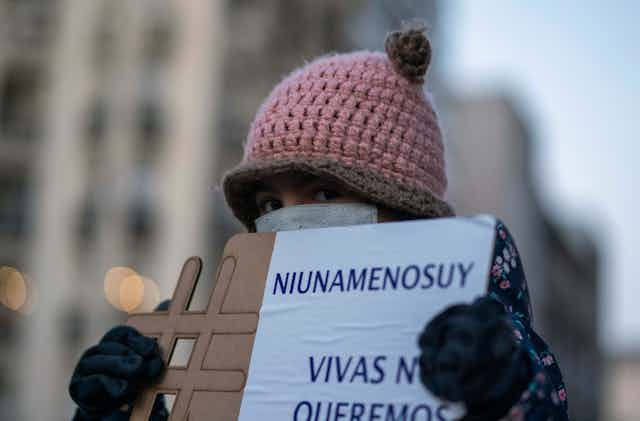The 16 Days of Activism against Gender-Based Violence is an annual campaign that begins on Nov. 25, the International Day for the Elimination of Violence against Women.
This date was chosen to commemorate the Mirabal sisters — Patria, Minerva and María Teresa — who were assassinated on Nov. 5, 1960 for their political activism in the Dominican Republic against the decades-long dictatorship of Rafael Trujillo.
Feminist movements in Latin America have a long history and have led to important shifts to understanding gender-based violence at the national, regional and international levels.
Beginnings of the global movement
In the 1970s, women’s groups were concerned with the role of the state as a perpetrator of violence against women in contexts of political repression. Women in Argentina (Mothers of the Plaza de Mayo), Mexico (Comité Eureka) and El Salvador (CoMadres), to name some examples, used public spaces to voice their suffering and demand justice in the face of state-sponsored violence.
In 1975, the first UN World Conference on Women held in Mexico City, in addition to the establishment of the UN Decade of Women (1976–1985), made regional and national feminist organizing visible.
During the 1980s, Latin American and Caribbean feminist activists and groups organized regular meetings, or encuentros, to exchange experiences, perspectives and mobilization strategies. During their first encuentro in Bogotá, Colombia, Nov. 25 was declared as a Day To End Violence Against Women.
By the end of the 1990s, most Latin American states had passed legislation addressing domestic violence. However, their implementation has been limited.
Gender and economic inequality
Following economic changes due to neoliberal policies, mobilization for economic justice became part of organizing for gender equality. For example, Mexican women have been organizing for decades against deadly violence tied to precarious working conditions for women on the United States and Mexican border.
Between 1993 and 2014, 1,500 women were murdered in Ciudad Juaréz. Most of them were young women, between the ages of 15 and 25, from low socio-economic backgrounds, working for maquiladoras – foreign-owned companies — under precarious conditions.
In 2009, several civil society groups organized the march “Éxodo por la vida de las mujeres” (Exodus for women’s lives) from Mexico City to Ciudad Juaréz. Among the organizations were Women in Black, whose slogan was Ni Una Más (Not One More). They were dressed in black to mourn the hundreds of missing and murdered women across the country, and wore pink hats to emphasize the youthful ages of the murdered women in Ciudad Juaréz.
At the same as the march was taking place, the Inter-American Court of Human Rights (COIDH) publicized its ruling on the case based on the murders of three young women in Ciudad Juaréz — Claudia Ivette Gonzalez, Esmeralda Herrera Monreal and Laura Berenice Ramos Monárrez.
The court’s decision was significant because it found that the state had violated these women’s human rights through negligence and victim-blaming. Additionally, this ruling recognized the state’s role in reproducing gender inequality and held it legally responsible for the prevention of feminicide, the killing of cis- or trans-women, because of their gender.
By 2015, 17 Latin American countries had passed legislation recognizing femicide, including the political and judicial structures that enable it.
Online organizing
In 2015, Argentinian journalists used the hashtag #NiUnaMenos (Not One Less) on Twitter to organize a march demanding that the state comply with its administrative and legal obligations of preventing femicide and to ensure the access to justice for victims.
Platforms such as Facebook and Twitter helped organizers share their message broadly and expand existing social networks. However, assemblies were still used for discussion and decision-making. As a result, the street demonstrations, which drew hundreds of thousands of women to the streets, position gender and sexual violence as a public issue.
The use of the hashtag and demonstrations quickly spread transnationally, and protests were organized in other Latin American countries including Chile, Mexico and Peru.
On Nov. 25, 2019, hundreds of Chilean women gathered in Santiago to dance a synchronized choreography led by Las Tesis denouncing gender violence. The song “Un Violador en tu camino” (The rapist is you) shifted the blame away from women who experienced sexual violence to agents of the state including police, judges and the president. The song quickly spread and performances were organized across the world from Latin America to Europe and the Middle East.
In Toronto, members of various Latin American groups put out a call that year to begin practising the choreography and organize a performance outside city hall. Initially, the call was intended as an act of solidarity with women in Latin America, who had been victims of sexual violence perpetrated by police amidst anti-government protests.
At the same time, governments — not only in Latin America, but also in Canada — are responsible for perpetuating gender inequality through economic policies and police violence.
When my friends and I saw the call on social media to join the performance at Toronto city hall, we felt moved to express our rage against the ongoing violence against women globally.

